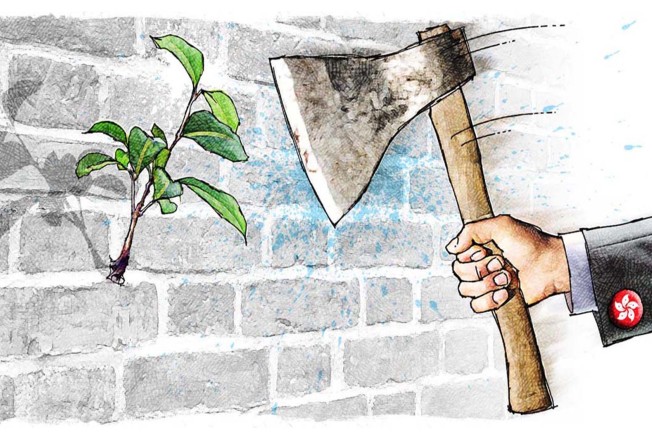Green envy: Hong Kong's grey urban environment put to shame by lush Singapore
Oren Tatcher laments our barren urban areas, which stand in stark contrast to the city greenery in Singapore, and on the mainland

Just as the green oasis of Singapore was getting ready for its 50th birthday celebration - part of it involving the mass planting of trees - the Hong Kong government cut down four beautiful, mature Chinese banyan trees on Bonham Road, which offered a rare green respite in the Mid-Levels' concrete jungle. Perhaps it was meant to send a defiant message to our eternal rival to the south: you have your ways, we have ours.
You don't have to be a fan of Singapore to be envious of its remarkable, ongoing greening project: tree-lined boulevards, lush parks, well-manicured potted plants. In fact, we don't even need to go so far afield as Singapore to get green envy: right across the border and all over the mainland, well-designed and well-maintained street landscaping and urban parks offer a beautiful antidote to the otherwise drab urban environment of modern Chinese cities.
These efforts stand in stark contrast to our own barren urban environment, much of it designed and managed by the Highways Department, for which smooth traffic flow is the top priority and the concept of pedestrian comfort is not a shading tree, but a footbridge leading to the nearest air-conditioned shopping mall.
Our government officials often boast in international forums how much of Hong Kong's land area is green, referring to our outstanding country parks. Focusing on country parks disguises the abysmal reality of our urban parks, which are much more relevant to the daily lives of a majority of Hong Kong's residents.
There, we face not only a scarcity - far less park space per resident than one would encounter in other major cities - but also very poor quality: our government's concept of an urban park appears to be a facility where tiles far outnumber leaves, and where plants, selected for their low-maintenance value, must be kept behind fences, presumably to protect them, and perhaps us, too.
But what's at stake in this case is street trees. Contrary to what many people think, we do have them in abundance, mostly in new urban areas - except we no longer have streets in those parts, only wide roads connecting mega developments, and therefore of less enjoyment to pedestrians.
Our tree-lined boulevards are often nothing but scenic driveways, shading empty footpaths while pedestrians scramble between commercial podiums and elevated walkways. In the congested old urban areas, street trees are few and far between, severely pruned and never adding up to anything even close to what could be called a "tree-lined street".
Which is why clusters of stone wall trees, with their gnarly roots and lush canopies, stand out so much in our urban environment and are so precious.
In contrast to the greenery nurtured by the nanny state to the south, or the podium-top, potted-planted "gardens" built by our developers, these stealthy urban creatures are true Hong Kong entrepreneurs, spontaneously growing out of crevices and thriving without the help of the Leisure and Cultural Services Department.
Indeed, the assault on these trees may just be part of the current campaign against Hong Kong's laissez-faire ways: it's time for some government intervention to rein in outdated free-wheeling greenery!
More likely, there is no nefarious anti-tree campaign under way; just the usual mix of indifference, risk aversion and lack of vision, which is increasingly the hallmark of our government's actions.
Naturally, the Highways Department cited concerns for public safety as the reason for this particular act, and according to reports in this newspaper, the Development Bureau's Tree Management Office said they agreed with the Highway Department's decision, without consulting its own panel of experts, who just a few days earlier seemed to have contemplated other solutions.
It smacks of bureaucrats, faced with a complex situation, resorting to the simplest and least-risky solution and acting swiftly before their intentions and actions can be called into question.
No one can play down safety concerns; surely not even the most ardent tree-huggers want to see anyone get hurt by a falling tree. It is also clear that our climate and terrain present ongoing challenges to keeping the public safe from natural events, as numerous incidents have sadly shown over the years. But rather than taking the easiest course of action - the irreversible felling of mature trees at the first sight of a problem - we have the right to demand that our government be more judicious, and explore sustainable solutions while taking the necessary temporary measures to ensure public safety.
The technical capabilities are there. Our Geotechnical Engineering Department possesses world-class expertise on green slopes; given a bit of time, surely they could have found solutions to keep those banyan trees safely in place.
But in our fragmented government, where streets are not in anyone's portfolio, protecting wall trees falls through the cracks, as does fixing broken pavements or controlling the rampant installation of unnecessary railings.
We can't blame the Highways Department for doing what it is meant to do - secure the flow of vehicles. But until streets are defined as positive public assets, worthy of design and protection, rather than the residual outcome of various public and private works, and are placed in the hands of a government entity with cross-departmental authority and the required technical tools, we will continue to see our urban environment shaped by those equipped with drills and chainsaws, rather than a civic vision.
Oren Tatcher is an architect and a member of the Hong Kong Institute of Urban Design